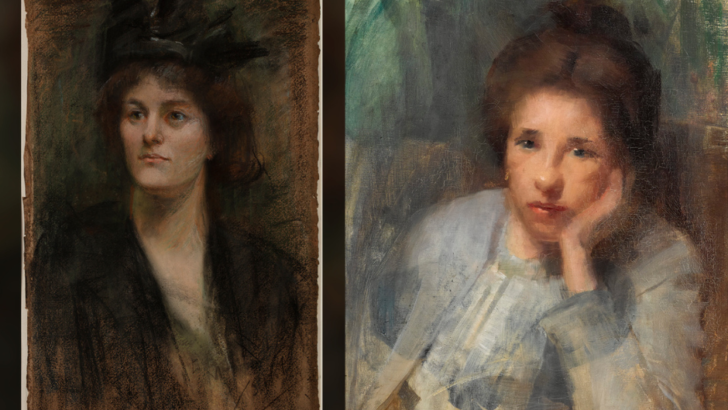More Power to You: Sarah Purser, a force for Irish Art: A major exploration of Sarah Purser (1848-1943), her extraordinary legacy, and enduring impact on the Irish arts scene
Curated by Logan Sisley, Head of Collections, Hugh Lane Gallery
The major exhibition at the Hugh Lane Municipal Gallery for the autumn of this year is devoted to a show on the remarkable Sarah Purser, whom the organisers call “a force in Irish art”.
For the curious, what remains of her top-lit studio at 11 Harcourt Terrace still survives. But her long-time home, Mespil House, was torn down shortly after her death in 1943, and the site and grounds cleared to make way for blocks of flats, then new to Dublin. In this way the old made way for the new, though a magnificent ceiling was retried by the OPW and now graces Áras an Uachtaráin.
The exhibition includes a time line of her life, which reminds us that she was born in 1848 into post-Famine Ireland and died in 1943 during the darkest year of the Emergency. This is an historical context visitors should keep in mind.
Charming
A real charming item is a bust of a very young George Russell, the dreamy young man in Pim’s Drapery store, rather the older mystical AE; though this a youth one feels already with his own special vision.
There are, of course, images of other notable figures who were friends of hers, as well as people of consequence. But contrast the three images of Miss Maud Gone, one a full length portrait of the beautiful young woman with her pet monkey, whom the poet Yeats fell in love with, which contrasts with a slightly later one of a more warrior like woman, an image almost of Éire herself.
Sarah Purser was undoubtedly one of the most remarkable Irish women of her generation, a generation many think of as filled with remarkable women. Born into comfortable circumstances, thanks to her own astute dealings in stocks and shares, she continued to live in style, but with resources to support all kinds of activities of the cultural life of Dublin and Ireland in her time.
This is not a grand show. It is quiet and domestic in many ways, demure perhaps in the current parlance of the internet. But there are remarkable things in it.
Almost the first item on exhibition, her sea-weed collector, at once strikes a new note that one is to see interesting pictures. One of these is an 1895 study for the portrait of a young girl, moody and almost sullen, but with a remarkable presence.
At the end of the show are three striking documentary photographs, of Miss Purser at a meeting of the National Gallery Board, in a group, and in lively conversation with James Montgomery, the then Film Censor and a renowned Dublin it: two figures of folklore in the Dublin of the Irish Revival.
Intermingled among her works and the works of other Irish artists, are examples of European painters which she helped to bring to Ireland through her efforts in the Friends of the National Collections of Ireland, or directly by her own purchase.
These represent sharply contrasting images, from an indifferent Duncan Grant contrasting with a fine impression of Concarneau by a French artist, one of a number of Europeans in the show.
There are many images that will linger in the mind from this show, making it one not to be missed”
There is an enjoyable sequence of contrast all through the exhibition. But one still sticks in mind. It is of Sara Purser standing, with her white cat, in the evening gloaming shortly before her death on the steps of Mespil House. It is by her friend Mary Swanzy, but what a contrast this image of gathering darkness is with the iridescent canvases Miss Swanzy had brought back from her travels through the South Seas two decades before.
But in a way it sums up those last years of Sarah Purser. One evening a departing friend later recalled, she paused on those steps to ask the much younger man about Dublin culture.
She had been a hostess noted for her Second Tuesday soirees often attended by up to 70 people. Those evenings belonged to the culture of her youth. Was it true, she asked, if cultural life was now transferred to the bars of public houses?
Remarkable
Ironically, also in the show there is a small painting of Kathleen Behan, one of five Miss Purser did of the young woman who was for a short time her housekeeper in the 1920s, another remarkable female, “the mother of all the Behans”.
Her son Brendan at that very time in the 1940s was serving terms of imprisonment in England and Ireland, where he was gathering some of the experiences that went into the making of his first book and play more than a decade later, products if ever there were of Dublin’s public houses.
There are many images that will linger in the mind from this show, making it one not to be missed, and which may well be a mind and eye opening experience for many visitors.


 Peter Costello
Peter Costello Miss Maud Gonne, 1898, by Sarah Purser (left, Courtesy the Hugh Lane Gallery)
Portrait Study, 1895, by Sarah Purser (right, Courtesy the Hugh Lane Gallery)
Miss Maud Gonne, 1898, by Sarah Purser (left, Courtesy the Hugh Lane Gallery)
Portrait Study, 1895, by Sarah Purser (right, Courtesy the Hugh Lane Gallery) 